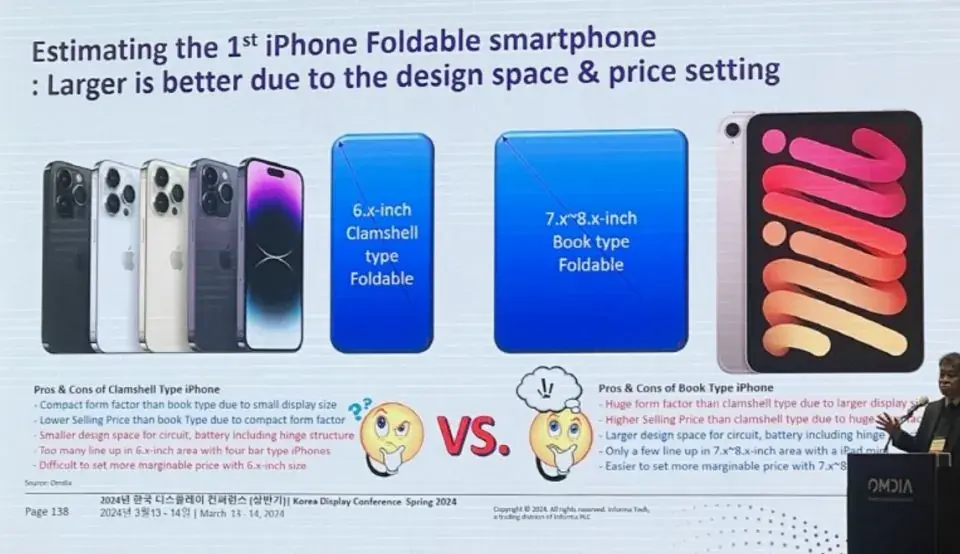Omdia, a renowned market research agency and consulting firm, has forecasted a groundbreaking development for Apple. This sets the stage for a significant shift in the landscape of mobile devices. Omdia recently held a press conference in Seoul, South Korea. Senior researcher Kang Min-soo talked about Apple’s OLED panel development plan and information about folding screens at the event. Notable predictions are that the first foldable iPhone will arrive in 2026 while an OLED iPad Air will launch in 2028.

A 7-8-inch foldable iPhone to launch in 2026
Since last year, there have been several rumours, speculations and even patents about Apple’s foldable iPhone. Foldable phones were popularized by Samsung and Huawei back in 2019. Since then, these brands as well as others have released several foldable phones. However, we are yet to see the first foldable iPhone. With regards to the launch of the first foldable iPhone, Omdia made a statement that says
We predict that Apple will launch a 7-8-inch foldable iPhone in 2026, the iPhone SE4 launched in 2025 will use low-temperature polysilicon (LTPS) TFT OLED, and the entire iPhone 17 series launched in the second half of next year will be equipped with LTPO TFT…(Foldable products of 7-8 inches) have more space in design (than small foldable products of around 6 inches), and Apple can learn from the foldable phone gameplay that many competitors have already done.
Currently, the only 7-8-inch product sold by Apple is the iPad Mini, which still uses LCD. This is an area where a 7-8-inch foldable could differentiate itself from the iPad Mini.
Apple will launch OLED iPad Air in 2028
When talking about the OLED iPad Air, Kang forecasted that Apple has serious plans for this product. He said
Apple’s iPad Pro plans to switch to an OLED panel this year, and we estimate that the iPad Air will also use OLED in 2028. Among them, the iPad Air will use a single-layer stacked OLED, and the iPad Pro will use a double-layer series OLED. The backplane (TFT) technology of both iPad Air and iPad Pro will use low-temperature polycrystalline oxide (LTPO), and power consumption will be an important factor for future OLEDs.

OLED notebook
On OLED notebooks, Kang believes that their demand will continue to increase. For this reason, many brands will make OLED notebooks and the competition will be high. He said
OLED demand for laptops is expected to expand due to the emergence of artificial intelligence or new high-end laptops. In the laptop market, unlike tablets, many brands compete with each other. We expect more companies to adopt OLED for differentiation.
Rigid OLEDs use a glass substrate and glass encapsulation, while single-stack OLEDs use a single light-emitting layer. Hybrid OLED (glass substrate + film cladding) and dual-layer tandem OLED (two light-emitting layers) (used in Apple’s OLED iPad) are superior to existing rigid OLEDs in terms of thickness, lifespan, and brightness (brightness). This means that PC brands will likely use rigid OLED as a relatively low-end product. Omdia predicts that global notebook OLED shipments will exceed 5 million units in 2024. However, this figure will increase 10 times to over 58 million units by 2030. Omdia’s year-by-year forecasts for notebook shipments are as follows
- 3.3 million units in 2023
- 5.1 million units in 2024
- 7 million units in 2025
- 18.5 million units in 2026
- 29.4 million units in 2027
- 42.7 million units in 2028
- 49.2 million units in 2029
- 58.1 million units in 2030.
Apple OLED iPad Pro to launch in 2028
According to Omdia, the company will unveil an OLED iPad Pro in four years to promote the development of OLED tablets. With regards to this, Kang Min-soo said:
The tablet market is almost monopolized by Apple, and even if (other companies) use hybrid OLED (glass substrate + film), not many brands can surpass Apple’s dominance. There are not many brands actively adopting OLED (in the tablet market), so global demand for tablet OLED is expected to be quite low.

From estimates, Samsung Display and LG Display will ship around 9 million iPad OLED units this year. Apple can fine-tune shipments after seeing the market response after launching the OLED iPad Pro from April to June. LG Display is producing 13-inch products, and Samsung Display is producing 11-inch products. Kang Min-soo estimates that global tablet OLED shipments will exceed 10 million units in 2024. He claims that by 2028, this figure will hit 30 million units. However, it will remain at just over 30 million units by 2030. Omdia’s year-by-year forecasts for tablet shipments are as follows
- 3.5 million units in 2023
- 10.3 million units in 2024
- 16.7 million units in 2025
- 22.3 million units in 2026
- 27.3 million units in 2027
- 29.6 million units in 2028
- 31.1 million units in 2029
- 32.1 million units in 2030





